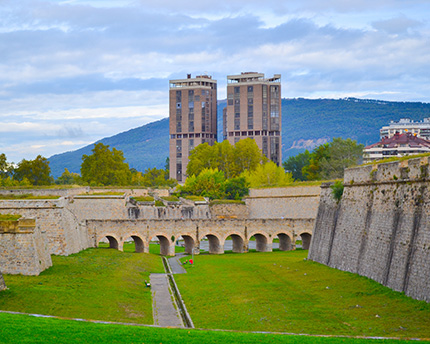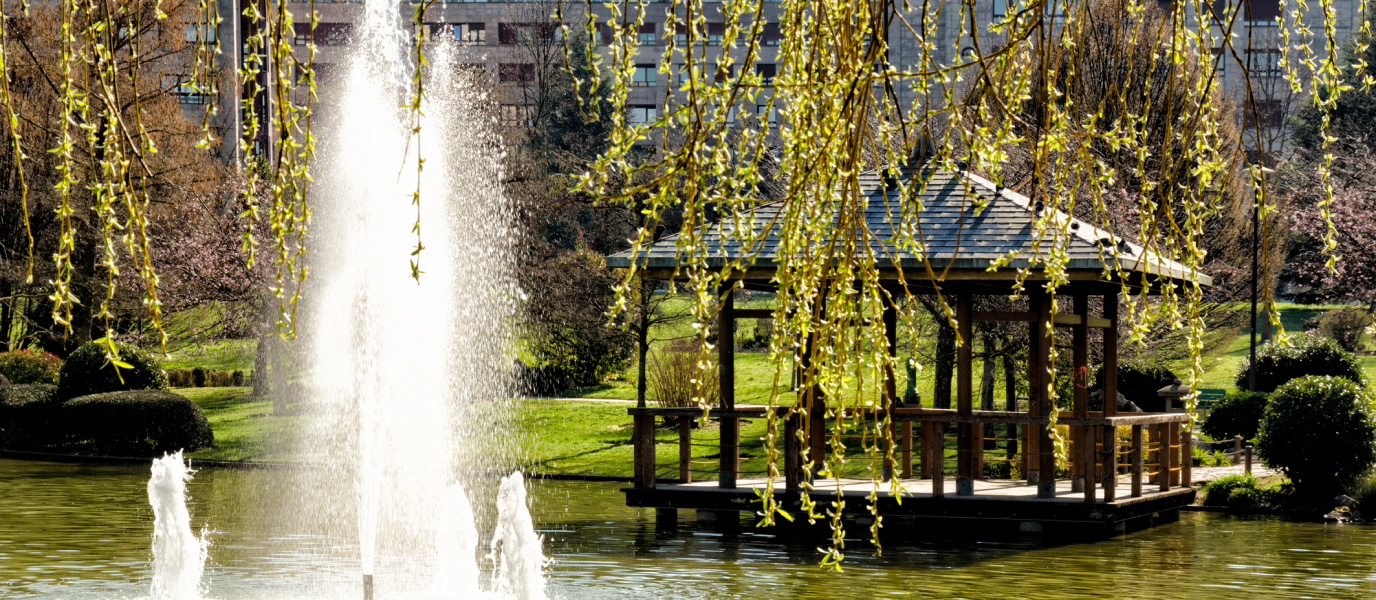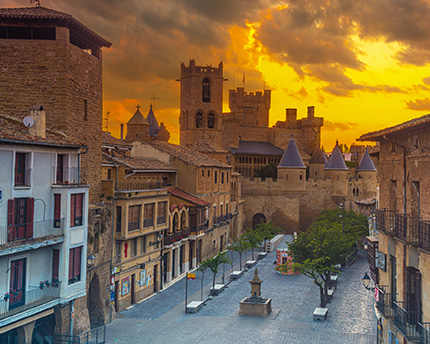Standing at the foot of the Roncevaux Pass (1057 m above sea level), which has been a natural entrance point to the Iberian Peninsula since Prehistory, the village of Orreaga/Roncesvalles is a landmark for everyone walking the French Way to the tomb of the apostle St James in Santiago de Compostela, 790 km to the west.
But that’s not all. This Pyrenean village is also steeped in history and lies in unspoilt surroundings that will take your breath away. Visiting Roncesvalles means enjoying all kinds of experiences linked to art, culture, nature and learning about the unique significance of this wonderful spot in the Navarran Pyrenees.
- What to see in Roncesvalles
- Where to eat in Roncesvalles
- What to see in the surrounding area
- Where to stay in Navarrea
What to see in Roncesvalles
This tiny spot is a hugely significant historical site, rather than being a village as such (it has fewer than twenty inhabitants). It’s both vital to the pilgrims who start their journey here towards Santiago and to the history of a border that has been decisive in shaping the future of Europe. Discovering Orreaga/Roncesvalles means coming face to face with a wealth of treasures.
Royal Collegiate Church of Santa María
This is the village’s most emblematic building, an impressive French Gothic church that was inspired by Notre Dame in Paris and clearly demonstrates the importance of Roncesvalles to the Way of St James. It was built on the orders of Sancho VII ‘the Strong’, King of Navarre (whose remains lie in the adjacent chapel of San Agustín) at the beginning of the 13th century but it was extensively refurbished at the start of the 17th century. Since its beginnings, it was designed to welcome pilgrims who entered Spain from France through the Roncevaux Pass. It has three naves and highlights of its interior include the beautiful Gothic sculpture of the Virgin of Roncesvalles (14th century), the colourful stained glass and rose windows, the pentagon-shaped chancel, large central nave and painted murals in the crypt, among other significant spaces and decorative features.
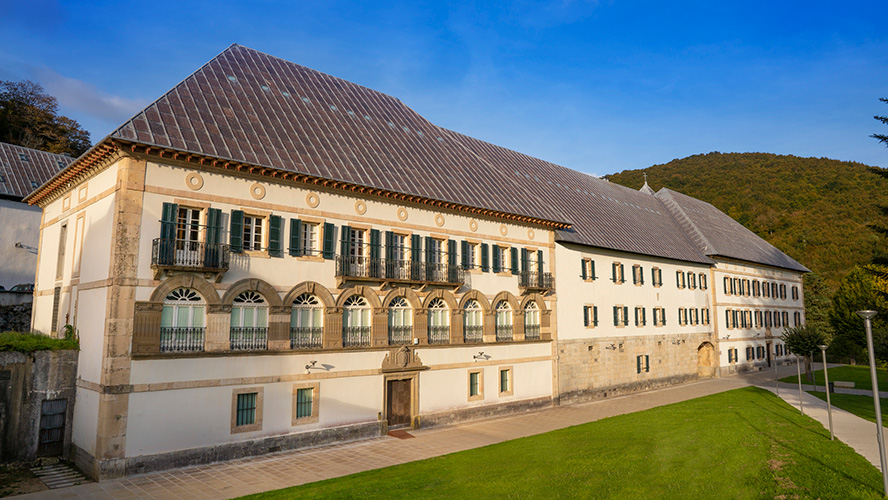
Additional parts of the complex are the 17th century cloister, the Priory and the chapel of San Agustín mentioned earlier. The Museum, Casa de los Beneficiados hotel and Pilgrim Hostel are a short distance away. Santa María de Roncesvalles is a historical and architectural gem, an Asset of Cultural Interest and one of the treasures that was included by UNESCO when the Way of St James was made a World Heritage Site.
The Tomb of the Giant King
The slab with a relief sculpture of Sancho VII ‘the Strong’ measures 2.25 m in length and legend tells that this was the actual height of the king. Whether that’s true or not, the chapel of San Agustín, also known as the Royal Chapel or Chapterhouse, is the resting place of the mortal remains of the famous King of Navarre who fought at the Battle of Las Navas de Tolosa, and who was key to the construction of the collegiate church of Roncesvalles. A triple arcade in the east wing of the cloister leads to the chapel. The royal tomb is in the centre, where it has lain since 1912 when the chapel was refurbished to commemorate the seventh centenary of the legendary battle of 1212.
Silo of Charlemagne
This unique Romanesque building is linked to another famous battle, the 778 Battle of Roncevaux Pass. It has a square floor plan and was built on the old chapel of the Holy Spirit. Twelve French knights are buried here, soldiers who fought and died for Charlemagne alongside Roland in the legendary battle. It originates from the 12th century but has undergone significant refurbishment and is the oldest building in the village. It sits above a well that was used as an ossuary for travellers who died in the hospital, and local residents.
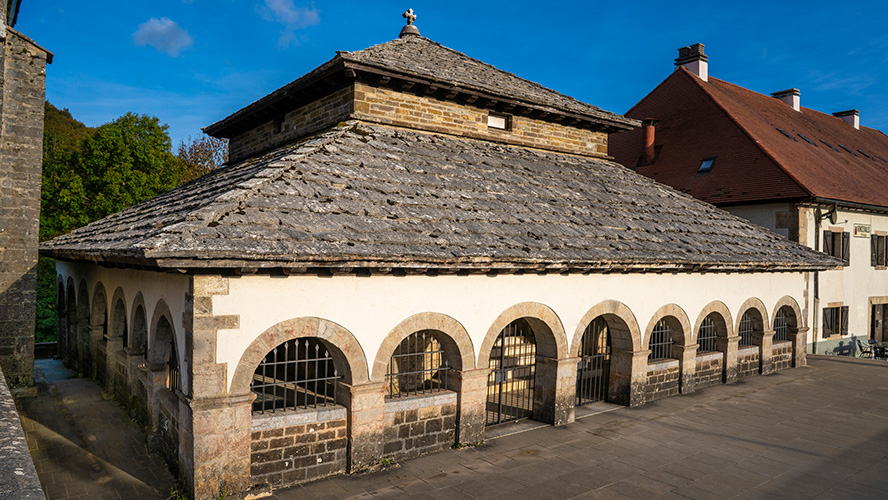
The Church of Santiago
This small, austere 13th century Gothic church stands to one side of the Silo of Charlemagne and is also known as the Pilgrim’s Church. It’s said that its bell, which came from the old chapel of San Salvador in Roncevaux Pass), guided pilgrims in foggy or stormy weather. Simply built with a rectangular floor plan, it was used as a parish church until the 18th century and was restored in the 20th century, when the legendary bell was installed. It’s one of the buildings that comprises the remarkable hospital complex of Roncesvalles.
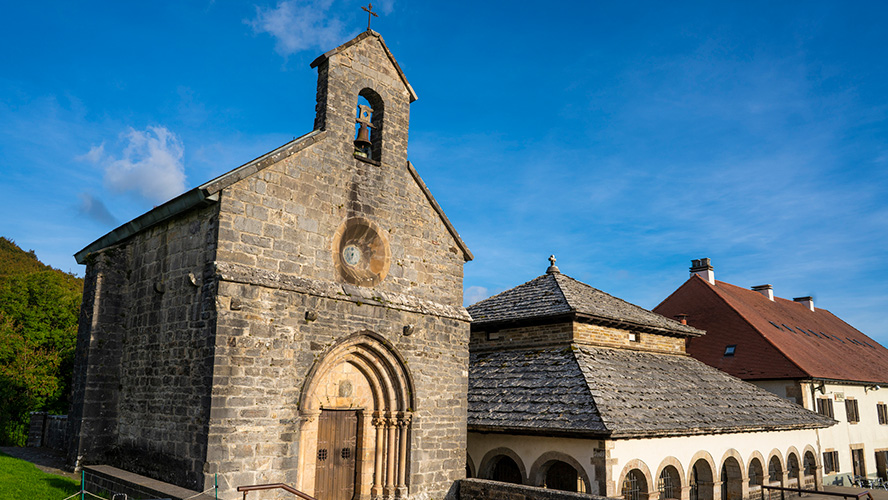
Museum of Orreaga/Roncesvalles
This small yet fascinating museum is next to the Priory and contains various items of great historical importance. Treasures such as the famous “Charlemagne Chess Set”, an exceptional piece that, according to legend, Charlemagne himself was playing chess on when he was told of the death of his nephew Roland and the defeat of the French army at the Battle of Roncevaux Pass. In fact, it’s a breathtaking Gothic-style reliquary laid out like a chequerboard and made of translucent enamel, glass, and sheets of gold plate, and dates from the second half of the 14th century. Another highlight is the “Muhammed al-Nasir Emerald” (Muhammed al-Nasir was the fourth emir in the Almohad Dynasty); the story goes that the gem was taken from the emir’s turban by King Sancho VII at the Battle of Las Navas de Tolosa. Sculptures, paintings, remarkable pieces of gold and silverwork, furniture, tapestries, coins and highly valuable books also form part of a collection that is well worth seeing.
The Fountain of the Virgin of Roncesvalles
Behind an 12th century medieval building called Itzandegia (which has been used as hay store, stables, a home and a hostel, and has now been refurbished as a multi-use hall), a pair of pipes framed by a few stone blocks, in the middle of a meadow, mark the place where, according to legend, local shepherds found the lost statue of the Virgin of Roncesvalles, Queen of the Pyrenees.
Where to eat in Roncesvalles
Visiting this corner of the Navarran Pyrenees is a wonderful opportunity to enjoy delicious local cuisine. Game (boar, deer, roe deer), river fish (trout, carp) and Pyrenean produce (mushrooms, sheep cheese, Navarran beef, pigeon) are used in dishes that epitomise the essence of life in the mountains.
La Posada de Roncesvalles
Housed in a (recently refurbished) historic building dating from 1612, this old pilgrim hostel continues to be a welcoming place for people on their way to Santiago. In addition to offering accommodation, La Posada also serves a great selection of local dishes, from typical Navarran beef to excellent home-made desserts.
Hotel restaurante Roncesvalles
The former “Casa de los Beneficiados” (1725) is next to the collegiate church and today is a great example of the hospitality that has always characterised this Pyrenean village. Its restaurant serves everything from a menu of the day to combination plates, full portions, sandwiches, salads, and home-made desserts, all made with high quality seasonal produce based on the principles of the slow food movement.
Casa Sabina
From great pintxos and full portions to its classic “pilgrim’s menu”, this hotel-restaurant is another great option when it’s time for a break along the Way. This peaceful and welcoming place is infused with the endless charm of its surroundings.
There are also several restaurants in neighbouring Auritz/Burguete that serve the best of Navarran cuisine, such as Asador Aritza, Restaurante Txikipolit and the restaurant at Hotel Loizu, among others. And there are yet more in Aurizberri/Espinal (just 6 km from Roncesvalles), such as Restaurante Baratze and Hostal Restaurante Haizea.
What to see in the surrounding area
Nature is definitely one of the biggest draws here and Orreaga/Roncesvalles is utter paradise for hiking fans. Aside from the Way of St James, which you can follow to ascend to Roncevaux Pass or to visit neighbouring villages, there are several trails that are a fantastic way to explore the area:
El Camino de los Canónigos
Governed by the rule of San Agustín, life for the canons of Roncesvalles was subject to a series of strict laws. One dictated that they could only occasionally go beyond the walls of the collegiate church to take a walk along this path. The route is under 2 km long and gives you a beautiful view of the whole complex, taking you to different historical attractions in the area, including Roland’s Fountain, where the legendary French commander and nephew of Charlemagne is said to have been injured. It also leads to the Pilgrims’ Cross, an important landmark along the Way, and the Fountain of the Virgin.
Basajaunberro Forest
This easy, circular trail is around 4 km long and takes just over an hour, so it’s perfect for families. It starts from the collegiate church and takes you along a forest track through beech and ancient oak trees. It’s a magical setting where witches’ covens were once held; its name refers to Basajaun, the ‘lord of the forest’, a character from Basque-Navarran mythology.
Bunkers of Ibañeta Trail
Three well-signposted trails (around 8 km of low/moderate difficulty, taking around 3 hours) follow the border that separates France and Spain, a frontier naturally defined by the Pyrenean mountains. They are a great opportunity to discover the remains of the line of fortifications built by Franco’s dictatorship to prevent a hypothetical invasion of Spain at the end of the Second World War.
Of course, it’s also worth visiting nearby villages like Auritz/Burguete (historically known as Burgo de Roncesvalles) and Aurizberri/Espinal. These two villages once again reveal the distinctive way of life at the top of the mountain range. A stunning mountain landscape is the backdrop to old cemeteries with grave stelae, charming examples of Pyrenean architecture, small churches and hermitages, dolmens, washing places, and old bridges. The appeal of these wonderful attractions is only intensified by a series of authentic traditions, from patron saint festivals and romerías to food that is closely linked to the landscape and its people.
Where to stay in Navarre
Visiting Navarre is a chance to enjoy unique experiences, including a first-class stay at the Occidental Pamplona. This four-star hotel by Grupo Barceló in the heart of Pamplona is close to many of the city’s main attractions (the Citadel, Yamaguchi Park, Planetarium, University of Navarre, etc.) and has 89 large, bright and fully equipped rooms. Its restaurant serves dishes made from the finest fresh, seasonal produce and it also has a lively lobby bar. Even better, it’s less than 50 km from Orreaga/Roncesvalles.
























































